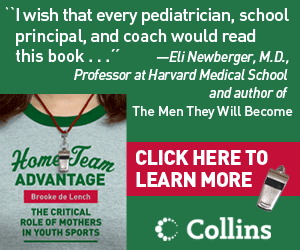Every parent of a child playing contact or collision sports has the right to expect that:
- A concussion education and safety meeting is held for parents and athletes before every sports season. It is now the law in forty-eight states and the District of Columbia that both athletes and their parents be provided with concussion and head injury information sheets and sign written consent forms indicating they are aware of the risks of concussions before each season, but an actual concussion safety meeting before the beginning of every season for contact and collision sports is strongly recommended. Simply put, way more concussion information should be provided parents and athletes than can fit on an 8 1/2 by 11 sheet of paper;
- The coach is a part of the concussion solution not part of the concussion problem, first and foremost, by creating an environment for athletes in which they feel safe honestly self-reporting concussion signs or symptoms (which emerging research shows plays a far more critical role in increasing reporting rates than simply educating athletes about the dangers of concussion), and, equally as importantly, by teaching proper tackling, which can reduce the risk of concussion and catastrophic head, neck and spine injuries.

- Their child's program has adopted and enforces conservative guidelines for evaluating and managing concussions, including both immediate removal from play or practice and no same day return to play in case of suspected concussion, and no return to play after a diagnosed concussion until cleared by a medical professional , ideally only after completing the graduated exercise program recommended by experts [Note: forty-seven states and the District of Columbia have enacted laws requring medical clearance before a return to play; New Mexico goes further, requiring a minimum seven-day waiting period to play sports after a concussion; New Jersey guidelines suggest such a waiting period as well];
- The athletic department has a certified athletic trainer (AT) on staff, which a 2011 study shows substantially increases the likelihood that a concussion will be recognized and treated. Two-thirds of parents in a 2010 survey supported a requirement that an AT be at all practices and games, although they disagreed on how to pay for the trainer. Statistics released by the National Athletic Trainers' Association in 2015 show that approximately seven out of ten U.S. secondary schools with an ongoing athletic program now have access to athletic trainers (ATs), whether full-time or part-time, which is double the NATA's 1994 estimate finding that only about 35% had such access. Approximately 70% of U.S. high schools have an AT at games and practices every day, and that 86% of all high school athletes now have an AT working with them on a daily basis. In some states, however, the number is much lower (Over three-quarters of Nebraska high schools, for instance, are without ATs). Most state high school associations still do not require a trainer at high school football games. In the absence of an AT, some programs (USA Football, for example) are trying to make sure, especially at the youth level, that someone with training in recognizing and responding to the signs and symptoms of concussion is designated to be on the sideline of every game or practice;
- Every child in a contact sport undergoes comprehensive pre-season baseline testing: (a) computerized neuropsychological/neurocogntive (NP), (b) balance (BESS), and (c) visual (King-Devick);
- Their child's athletic programs requires that each athlete undergo a comprehensive pre-participation physical examination (PPE) which includes the taking of a detailed concussion history (diagnosed/undiagnosed), questions on risk factors (ADD, ADHD, migraines, depression, family history of neurological disorders, e.g. Alzheimer's, early dementia, ALS, MS, Parkinson's);
- Parents or guardians receive written notice of concussion injuries and must give written consent before their child is allowed to return to play (many of the new concussion safety laws make such notice and consent mandatory);
- Every child is provided with a safe helmet, which one that fits properly, has been properly reconditioned, and has not exceeded its useful life (a ban on reconditioning of football helmets more than 10 years old went into effect in September 2011). Programs in contact and collision sports should consider purchasing impact sensors - whether they be installed inside or on a helmet, are embedded in a skullcap, earbud, chinstrap or mouth guard - to give sideline personnel (preferably an athletic trainer or team doctor) what amounts to an additional set of eyes and ears with which to identify concussed athletes;
- An ambulance and paramedics are present at all high school football games, and, if they are not, an emergency medical plan is in place, including on how to properly contact EMS. 911 should be called if there is a deterioration of symptoms, loss of consciousness, or direct neck pain associated with the injury (for more on the proper management of acute spinal injuries on the athletic playing field, click here);
- Coaches and officials are required by law to be trained and certified in basic safety and emergency procedures, including concussion safety. Again, this is a feature of many, but not all, of the new state concussion laws and is recommended by the NFHS (whose concussion education video has now been viewed more than a million times), USA Football (as part of its Heads Up football program) and Pop Warner;
- Game officials are given the right to send any athlete who they reasonably suspect has suffered a concussion during play to the sideline for further evaluation (the laws in two states, Arizona and Iowa, contain such a provision). Several states also allow parents to pull their child from a practice or game in case of suspected concussion;
- The national governing body for their child's sport has taken steps to address concussions, both in terms of education (especially of coaches and parents in creating a safe concussion reporting environment) and prevention (including limits on full-contact practices and spring practices, as an increasing number of state athletic associations and organizations such as Pop Warner are implementing), body checking in ice hockey (as USA Hockey did several years back for players below age 13), safety rules and rules enforcement.
While I recognize that many of these goals are more than anything aspirational and will take time to achieve, they are goals towards which all of your youth sports programs should work. Implementing even one will reduce the number and severity of concussions. Adopting and following them all, while it won't make youth sports a concussion-free zone, will make sports as safe as it can reasonably be.
Brooke de Lench is Executive Director of the non-profit MomsTEAM Institute of Youth Sports Safety, Founder and Publisher of MomsTeam.com, Producer/Director/Creator of the PBS concussion documentary, The Smartest Team: Making High School Football Safer, and a long-time concussion safety advocate.
For the most comprehensive, up-to-date concussion information on the Internet, click here.
Most recently revised and updated April 13, 2016









